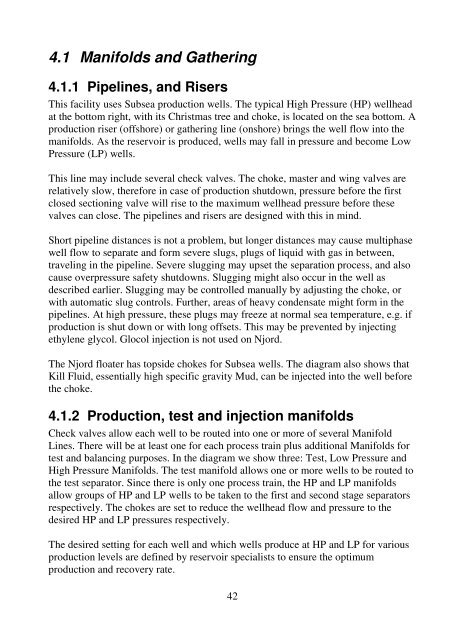Oil and gas production handbook - Process Control and ...
Oil and gas production handbook - Process Control and ...
Oil and gas production handbook - Process Control and ...
You also want an ePaper? Increase the reach of your titles
YUMPU automatically turns print PDFs into web optimized ePapers that Google loves.
4.1 Manifolds <strong>and</strong> Gathering<br />
4.1.1 Pipelines, <strong>and</strong> Risers<br />
This facility uses Subsea <strong>production</strong> wells. The typical High Pressure (HP) wellhead<br />
at the bottom right, with its Christmas tree <strong>and</strong> choke, is located on the sea bottom. A<br />
<strong>production</strong> riser (offshore) or gathering line (onshore) brings the well flow into the<br />
manifolds. As the reservoir is produced, wells may fall in pressure <strong>and</strong> become Low<br />
Pressure (LP) wells.<br />
This line may include several check valves. The choke, master <strong>and</strong> wing valves are<br />
relatively slow, therefore in case of <strong>production</strong> shutdown, pressure before the first<br />
closed sectioning valve will rise to the maximum wellhead pressure before these<br />
valves can close. The pipelines <strong>and</strong> risers are designed with this in mind.<br />
Short pipeline distances is not a problem, but longer distances may cause multiphase<br />
well flow to separate <strong>and</strong> form severe slugs, plugs of liquid with <strong>gas</strong> in between,<br />
traveling in the pipeline. Severe slugging may upset the separation process, <strong>and</strong> also<br />
cause overpressure safety shutdowns. Slugging might also occur in the well as<br />
described earlier. Slugging may be controlled manually by adjusting the choke, or<br />
with automatic slug controls. Further, areas of heavy condensate might form in the<br />
pipelines. At high pressure, these plugs may freeze at normal sea temperature, e.g. if<br />
<strong>production</strong> is shut down or with long offsets. This may be prevented by injecting<br />
ethylene glycol. Glocol injection is not used on Njord.<br />
The Njord floater has topside chokes for Subsea wells. The diagram also shows that<br />
Kill Fluid, essentially high specific gravity Mud, can be injected into the well before<br />
the choke.<br />
4.1.2 Production, test <strong>and</strong> injection manifolds<br />
Check valves allow each well to be routed into one or more of several Manifold<br />
Lines. There will be at least one for each process train plus additional Manifolds for<br />
test <strong>and</strong> balancing purposes. In the diagram we show three: Test, Low Pressure <strong>and</strong><br />
High Pressure Manifolds. The test manifold allows one or more wells to be routed to<br />
the test separator. Since there is only one process train, the HP <strong>and</strong> LP manifolds<br />
allow groups of HP <strong>and</strong> LP wells to be taken to the first <strong>and</strong> second stage separators<br />
respectively. The chokes are set to reduce the wellhead flow <strong>and</strong> pressure to the<br />
desired HP <strong>and</strong> LP pressures respectively.<br />
The desired setting for each well <strong>and</strong> which wells produce at HP <strong>and</strong> LP for various<br />
<strong>production</strong> levels are defined by reservoir specialists to ensure the optimum<br />
<strong>production</strong> <strong>and</strong> recovery rate.<br />
42
















